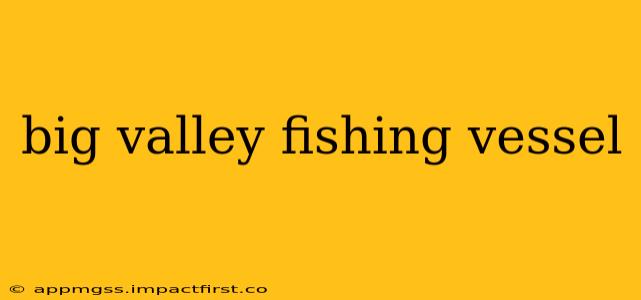The term "Big Valley Fishing Vessel" isn't a specific, officially recognized class of fishing boat. Instead, it likely refers to a large fishing vessel operating in or near a geographical area known as "Big Valley." This ambiguity necessitates a broader approach to understanding the topic, exploring various aspects of large commercial fishing operations and the types of vessels involved. This article will delve into the characteristics, operations, and challenges faced by large fishing vessels, regardless of their specific naming convention.
What Types of Vessels are Considered "Large"?
The definition of "large" in the context of fishing vessels is relative. However, we can categorize them based on size, tonnage, and fishing methods. Large fishing vessels often fall into these categories:
-
Factory Trawlers: These massive vessels process and freeze catches onboard, extending their time at sea and significantly increasing their catch capacity. They are typically over 100 meters in length and employ sophisticated technologies for fish detection and processing.
-
Seiners: While varying in size, large seiners use purse seines to encircle schools of fish. Their size depends on the target species and fishing grounds but can be substantial, often exceeding 50 meters.
-
Longliners: These vessels deploy long lines with thousands of baited hooks, targeting species like tuna and swordfish. Larger longliners enhance efficiency with advanced technology and greater storage capacity.
What are the Challenges Faced by Big Valley Fishing Vessels (or Vessels of Similar Size)?
Operating large fishing vessels presents numerous challenges:
-
High Operational Costs: Fuel, maintenance, crew salaries, and processing equipment contribute to substantial operational expenses. Fluctuations in fuel prices significantly impact profitability.
-
Environmental Regulations: Increasingly stringent regulations aimed at sustainable fishing practices require compliance with complex rules, potentially limiting fishing areas and methods.
-
Weather Conditions: Large vessels are more susceptible to extreme weather, posing risks to safety and operations. Navigating challenging sea conditions requires skilled crews and robust vessel design.
-
Market Volatility: The price of seafood fluctuates based on supply, demand, and market trends. This unpredictability impacts the financial viability of fishing operations.
What are the Common Fishing Methods Used by Large Vessels?
Large vessels employ various fishing methods, depending on the target species and location:
-
Trawling: Dragging large nets along the seabed or through the water column to capture fish. This method is highly productive but can also have significant environmental impacts.
-
Purse Seining: Encircling schools of fish with large nets, which are then closed at the bottom to trap the catch. This is efficient for schooling fish.
-
Longlining: Deploying long lines with many baited hooks, targeting a wide range of pelagic species.
-
Gillnetting: Setting large nets that catch fish by their gills. This method is often used for specific species but can also lead to bycatch.
What Safety Measures are in Place for Big Valley Fishing Vessels?
The safety of crews on large fishing vessels is paramount. Various measures are employed:
-
Modern Navigation Systems: GPS, radar, and other electronic aids enhance navigation and safety, particularly in challenging conditions.
-
Emergency Equipment: Life rafts, life jackets, and emergency communication systems are essential for responding to accidents or emergencies at sea.
-
Crew Training: Comprehensive training programs equip crews with the skills and knowledge to operate safely and effectively in various scenarios.
-
Regular Vessel Inspections: Regular inspections ensure that vessels meet safety standards and are properly maintained.
What is the Economic Impact of Big Valley Fishing Vessels (or Vessels of Similar Size)?
Large fishing vessels contribute significantly to the economy:
-
Employment: They provide jobs for thousands of people, both directly in fishing operations and indirectly in processing, distribution, and support services.
-
Food Security: They supply a significant portion of the global seafood supply, contributing to food security in many regions.
-
Export Revenue: Seafood exports from large fishing vessels contribute substantial revenue to many countries.
This overview provides insight into the world of large fishing vessels, addressing the implied "Big Valley" context by focusing on the broader characteristics and challenges of operating such vessels. While the specific location and naming convention might vary, the core aspects of scale, operational complexities, and economic impact remain consistent across large-scale commercial fishing operations globally.
